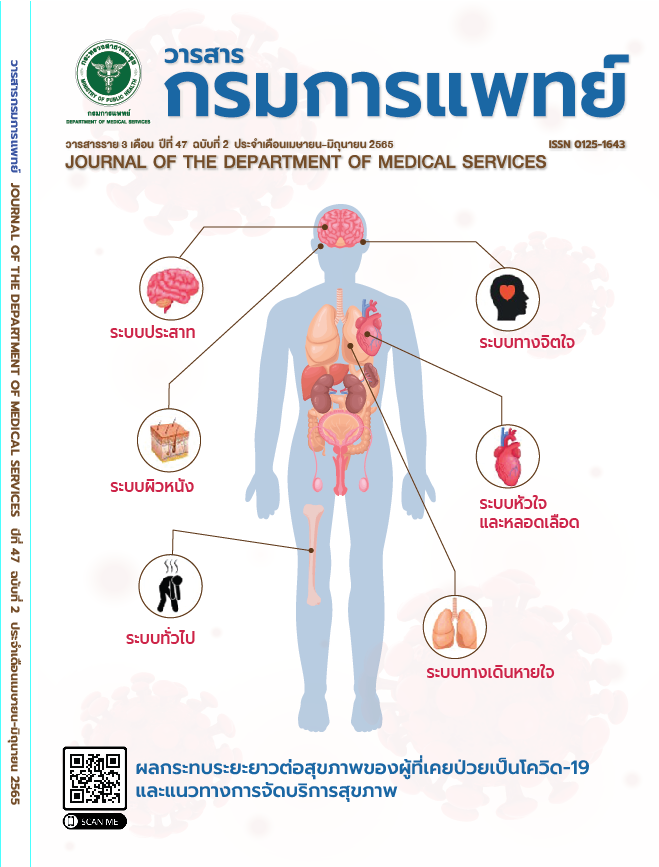The Effectiveness of Educational Program Using Cartoon Animation Video for Caregivers of Children with Epilepsy on Epilepsy Knowledge of Caregivers Among Children with Epilepsy
Keywords:
children with epilepsy, caregiver, educational program, Cartoon Animation VideoAbstract
Background: Epilepsy is a common neurological disorder and a major public health problem in Thailand. In children with epilepsy, it is necessary to receive proper care. The proper care can prevent and control seizures. Therefore, pediatric nurses need to be promote accurate epilepsy knowledge and understanding of epilepsy care that led to caregivers can properly care for children with epilepsy. Objectives: To examine the effect of educational program using cartoon animation video for caregivers of children with epilepsy on epilepsy knowledge of caregivers. Methods: This research was quasi-experimental research.( the one group pre-posttest design). The samples were caregivers of 36 children with newly diagnosed with epilepsy who were received antiepileptic drugs, aged 1-12 years. The statistics used for data analysis were one-way repeated measure ANOVA. Results: After the experiment, scores of epilepsy knowledge in caregivers were significantly higher scores than those before the experiment. (p<0.001) These finding showed that the educational program using cartoon animation video can enhance epilepsy knowledge. Conclusion: Educational program using video animation was a tool to improve epilepsy knowledge in caregivers of children with epilepsy. Therefore, nurse should use the educational program using cartoon animation video to promote epilepsy knowledge in caregivers, leading to appropriate care of children with epilepsy.
References
Shinnar S, Pellock JM. Update on the epidemiology and prognosis of pediatric epilepsy. Journal Child Neurol. 2002; 17 (Suppl.1): S4-17.
Camfield CS, Camfield PR, Gordon K, Wirrell E, Dooley JM. Incidence of epilepsy in childhood and adolescence : a population -based study in Nova Scotia from 1977 to 1985. Epilepsia.1996; 37(1): 19-23.
Asawavichienjinda T, Sitthi-Amorn C, Tanyanont W . Prevalence of epilepsy in rural Thailand: a population-based study. Journal Med Assoc Thai. 2002; 85(10): 1066-73.
Pongwatcharaporn, K. Factors predicting poor response to first antiepileptic drug in pediatric epilepsy. Medical journal of Srisaket Surin BurIram Hospitals 2020; 35(2):491-500.
Tawanrat S. Effect of Epilepsy on Children: Prevention and Treatment. Thai Journal of Nursing Council. 2018; 33(4): 5-18.
Chutimaporn K, Chuanruedee K, Wantana M, Anannit W. Factors Related to Medication Adherence among Children with Epilepsy. Ramathibodi Nursing Journal. January-April 2017; 23(1):44-59.
Ruedeeporn P, Chalida T. The effects of educative supportive program using VCD and handbook on caregivers’ caring behaviors for school age epilepsy. Journal of Nursing Science & Health. 2017; 40(2):11-21.
Thatcher JD. Computer animation and improved student comprehension of basic science concepts. The Journal of American Osteopathic Association. 2006; 106(1): 9-14.
Anannit W. Textbook of Epilepsy in Children. Holistic Publishing Co., Ltd; 2011.
Bandura A. Annals of child development.Six theories of child development Greenwich, Social cognitive theory.In R. Vasta (Ed.), CT: JAI Press 1989; 6:1-60.
Downloads
Published
How to Cite
Issue
Section
License
Copyright (c) 2022 Department of Medical Services, Ministry of Public Health

This work is licensed under a Creative Commons Attribution-NonCommercial-NoDerivatives 4.0 International License.
บทความที่ได้รับการตีพิมพ์เป็นลิขสิทธิ์ของกรมการแพทย์ กระทรวงสาธารณสุข
ข้อความและข้อคิดเห็นต่างๆ เป็นของผู้เขียนบทความ ไม่ใช่ความเห็นของกองบรรณาธิการหรือของวารสารกรมการแพทย์



